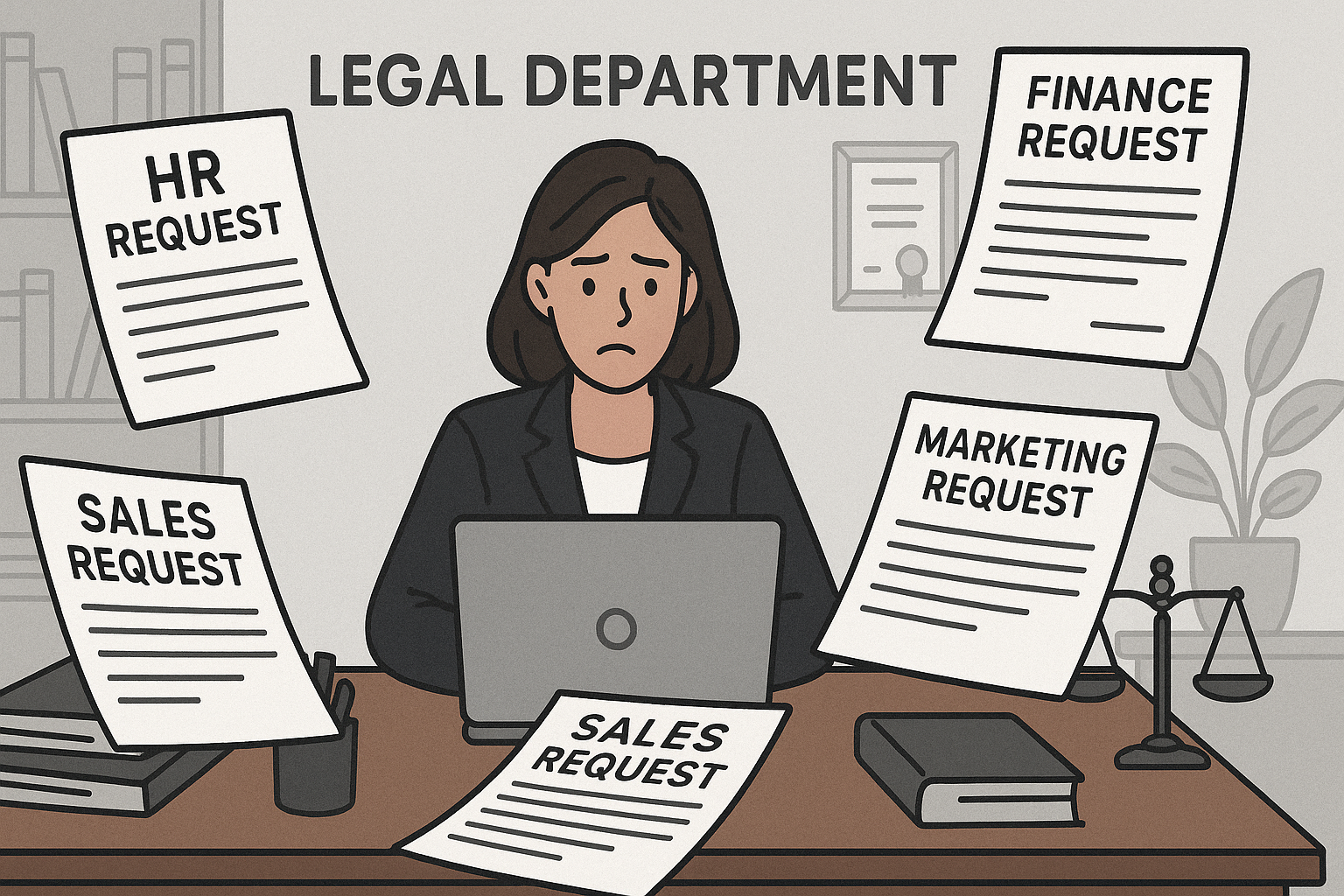
Problem Statement
In-house legal departments serve as the central point for managing legal affairs within an organization. They are routinely flooded with service requests from various internal departments such as HR, Finance, Procurement, Compliance, Sales, and Executive leadership. These requests range from contract reviews and compliance checks to litigation support and legal opinions. Without a centralized and efficient management system, these requests are often handled through fragmented communication channels—emails, chats, or informal conversations—which leads to poor visibility, delays, lack of prioritization, duplication of efforts, and ultimately increased legal risks and operational costs.
Moreover, legal teams often lack tools to track request statuses, assign priorities, analyze workloads, or measure performance. This manual and ad-hoc approach not only strains legal resources but also frustrates internal stakeholders awaiting timely resolutions. With increasing regulatory demands and limited resources, the current operational model is unsustainable.
There is a growing need for an intelligent, streamlined, and collaborative platform that can automate legal service intake, triage requests, provide transparency across departments, and integrate with other enterprise systems. Such a solution should empower legal teams to deliver faster, more accurate, and cost-effective services while ensuring compliance and risk mitigation.
Pain Points
- Fragmented Request Channels – Requests arrive via email, chats, or informal channels, making tracking and prioritization difficult.
- Lack of Visibility – Legal teams and requesters have no real-time status tracking, creating confusion and delays.
- Manual Triage Process – Assigning and categorizing requests manually is slow, inconsistent, and prone to oversight.
- Unclear Ownership – Ambiguity over who handles which task causes rework and bottlenecks.
- Inefficient Workflow – Repetitive processes without automation lead to wasted hours and errors.
- Delayed Turnaround Times – Without clear SLAs or metrics, responses are slow and unpredictable.
- Data Silos – No unified platform to access historical case data, legal documents, or interactions.
- Compliance Risks – Poor documentation and tracking can result in non-compliance and legal liabilities.
- Poor Analytics – No tools to measure performance, identify bottlenecks, or forecast resource needs.
- Integration Gaps – Legal workflows often disconnected from existing enterprise tools like CRM, ERP, or ticketing systems.
Stakeholders and Their Roles
- In-house Legal Teams – Primary users; manage, assign, and respond to legal requests.
- Legal Operations Managers – Monitor legal processes, optimize resources, ensure compliance.
- Internal Departments (HR, Finance, Procurement, Sales, Compliance) – Raise service requests to legal; consume outputs.
- Executive Leadership – Evaluate legal team performance, operational costs, and risk exposure.
- IT/Tech Teams – Support integration and deployment of legal service platforms.
- Compliance Officers – Ensure all legal workflows meet regulatory standards.
- Vendors & External Law Firms – May collaborate via shared access or task assignments.
- Project Managers – Oversee implementation and adoption of new legal tools.
- Finance Teams – Track legal spending and budgets.
- Auditors – Evaluate traceability and documentation of legal decisions and workflows.
Market Maturity
The legal tech market, particularly solutions for in-house legal departments, has seen rapid growth over the last five years. This has been fueled by:
- Increased legal workload complexity: Regulatory compliance, data privacy, ESG policies, and cross-border legal matters are growing.
- Cost pressures: Companies demand more efficiency from legal departments without increasing headcount.
- Technological acceptance: In-house teams are now more open to AI, workflow automation, and cloud platforms.
Gaps in the Market
- Unified Service Request Management: No dominant platform exists that centralizes intake, triage, SLA tracking, and department collaboration specifically for in-house legal service requests.
- Deep Enterprise Integration: Many tools work in silos or offer generic APIs, lacking native integrations with tools like Salesforce, SAP, Teams, or Jira.
- Triage & Prioritization Automation: AI-powered routing of tasks based on urgency, department, and legal specialty is nascent.
- Request Visibility for Business Units: Most tools focus on legal users but ignore the experience of internal departments raising the requests.
Major Offerings by Competitors
- AI-Powered Document Analysis: Tools like Harvey AI and Ironclad use AI to analyze and draft legal documents, improving accuracy and efficiency.Business Insider+1Business Insider+1
- Workflow Automation: Platforms such as Tonkean and Lawcadia offer automation of legal workflows, including matter intake, triage, and approvals.Tonkean+1lawcadia.com+1
- Contract Lifecycle Management: Ironclad and Agiloft provide comprehensive solutions for managing the entire contract lifecycle, from creation to execution.Wikipedia
- Client Intake and CRM: Clio offers features for client intake, contact management, and client relationship management.Briefpoint+2Clio+2Wikipedia+2
- No-Code Automation: Lawcadia and Streamline AI enable legal teams to create and manage workflows without the need for coding expertise.lawcadia.com+1Streamline AI+1
- Integration Capabilities: Many platforms integrate with existing enterprise systems, such as Microsoft, Google, and Box, to streamline legal operations.Workstorm
- Security and Compliance: Solutions like Workstorm emphasize secure communication and compliance features, including end-to-end encryption and SOC 2 compliance.Workstorm
- Analytics and Reporting: Platforms provide analytics tools to measure performance, identify bottlenecks, and forecast resource needs.
Product Vision
LexFlow envisions a centralized, intelligent legal service management platform that transforms how in-house legal departments receive, manage, and respond to internal service requests. The core vision is to eliminate inefficiencies by building a system that automates legal request intake, standardizes triage, ensures visibility, and integrates seamlessly into an organization’s broader ecosystem.
LexFlow will function as a legal operations command center—enabling internal departments to submit requests through structured, user-friendly forms. These will be automatically categorized and routed using AI-driven triage, ensuring faster processing and alignment with legal expertise. For legal professionals, LexFlow will offer workload dashboards, task prioritization, document tracking, and performance analytics—all tailored for real-time monitoring and strategic decision-making.
The platform will integrate with tools like Microsoft Teams, Slack, Salesforce, and contract repositories to ensure minimal context-switching and complete visibility. Its built-in compliance checker, SLA tracking, and secure audit logs will reduce legal and operational risk.
In a maturing market ripe with general-purpose legal tools, LexFlow differentiates itself by being deeply enterprise-integrated, process-specific, and built with the dual focus of productivity and risk governance. The long-term vision includes incorporating generative AI to draft contracts, recommend actions, and summarize case progress.
Use Case
1. Automated Legal Request Intake
Users from various departments can submit legal service requests via guided forms on a centralized portal. These forms standardize the input, ensuring all relevant information is captured—document attachments, deadlines, priority level, and department. The system auto-generates a case file and enters it into the legal queue.
2. AI-Based Request Triage
The system classifies incoming requests using NLP to detect priority, deadlines, and categories (e.g., contracts, compliance, litigation). Based on this, it auto-assigns or flags for manual routing.
3.Request Status Dashboard
Every department has access to a dashboard showing status of their requests—”Under Review,” “Waiting on Documents,” “Resolved,” etc. The legal team has its own view for workload management and SLA tracking.
4.Legal SLA Monitoring
Each request type is associated with default SLAs. The system tracks start/end times and flags approaching breaches. Trends and SLA reports are available weekly/monthly.
5.Enterprise System Integrations
LexFlow supports APIs and native integrations to intake requests from Salesforce, share updates via Slack, or archive signed contracts in SharePoint. This reduces duplication and improves workflow.
6.Performance Analytics & Forecasting
This module provides real-time dashboards and monthly reports on request volumes, resolution times, SLA breaches, team workload distribution, and recurring legal issues. AI forecasts request volume based on seasonal trends and business events.
7.Secure Document Management
LexFlow includes a secure document repository where legal teams can upload, search, share, and tag files. Version control and audit trails ensure document integrity and compliance.
8.Automated Legal Templates
Teams can use self-service tools to generate contracts, NDAs, and policy memos using legal-approved templates. Users fill forms that generate documents with dynamic clauses based on inputs.
9.Collaboration with External Counsel
When outside counsel is engaged, LexFlow allows controlled access to relevant files and tasks. Communication and document sharing happen within the platform, maintaining full audit trails.
10.Compliance & Audit Logs
Every action in LexFlow is time-stamped and logged—request creation, edits, approvals, uploads. Admins can generate audit-ready logs by user, department, or date range, aiding investigations and regulatory checks.
Summary
In-house legal departments face increasing pressure from multiple business units to manage legal requests efficiently. Traditional models relying on emails, chats, and scattered documentation cause delays, increase risk, and escalate operational costs. The proposed solution, LexFlow, aims to resolve this by offering a centralized, AI-powered legal request management platform.
LexFlow facilitates structured intake, automates triage, and ensures real-time visibility into all legal workflows. It addresses the diverse needs of stakeholders including internal departments, legal ops, finance, and external counsel. By integrating with enterprise tools like Salesforce and Microsoft Teams, and offering features like SLA tracking, secure document management, and generative AI for contract summarization, LexFlow creates a seamless legal operations environment.
The competitive landscape includes innovators like Harvey AI, Ironclad, and Tonkean, with significant investment backing the demand for automation in legal tech. However, a gap remains in providing a deeply integrated, use-case-specific platform focused on request visibility, workflow automation, and compliance monitoring. LexFlow bridges this gap with a scalable, extensible, and enterprise-ready system.
Fifteen detailed use cases were developed to guide the product roadmap, covering everything from AI-driven triage to legal budget tracking. With a target MVP launch in December 2025 and a full release by March 2026, LexFlow aims to redefine how legal departments operate—turning them from reactive units into proactive enablers of business efficiency.
